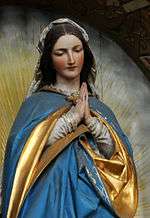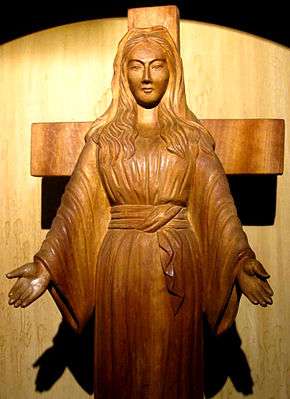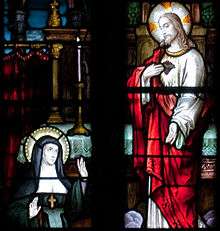Weeping statue
| Part of a series on the |
| Mariology of the Catholic Church |
|---|
 Virgo by Josef Moroder-Lusenberg |
|
|
|
|
|
A weeping statue is a statue which has been claimed to have shed tears or to be weeping by supernatural means. Statues weeping tears which appear to be blood, oil, and scented liquids have all been reported. Other claimed phenomena are sometimes associated with weeping statues such as miraculous healing, the formation of figures in the tear lines, and the scent of roses. These events are generally reported by some Christians, and initially attract some pilgrims, but are in most cases disallowed by the Church as proven hoaxes.
Weeping statue and Marian apparition

Reported weeping statues are most often of the Virgin Mary and are at times accompanied by claims of Marian apparitions. An unusual nature of the Our Lady of Akita apparitions was that unlike other cases the entire nation of Japan was able to view the tears of the statue of the Virgin Mary on national television.[1]
Hoaxes and skepticism
Authorities of the Catholic Church have been very careful in their approach and treatment of weeping statues, and generally set very high barriers for their acceptance. For instance when a statue of the popular Saint Padre Pio of Pietrelcina in Messina, Sicily, was found to have tears of blood one day in 2002, Church officials quickly ordered tests that showed the blood belonged to a woman and then dismissed the case as a hoax.[2][3]
Skeptics point to the fact that making a fake weeping statue is relatively easy. At some skeptic conferences, "do it yourself weeping statue kits" are on sale. Skeptics have provided examples of weeping statues that have been obvious hoaxes.[4]
Weeping statues have also been dismissed by rationalists as a purely psychological and/or fraudulent phenomenon. The witnesses are said to be deluded by their own state of mind or strong group suggestion. In this altered state of mind, they believe they see something that isn't really there.[5]
Another likely explanation attributes the so-called tears to condensation. The tears that statues appear to weep are actually beads of condensation accounted for by the statue being made from material of varying density, with condensation forming on the denser (colder) pieces (in this case the eyes).
A number of weeping statues have been declared fake by Catholic church officials.[6][7][8][9]
In 1995, a Madonna statue appeared to weep blood in the town of Civitavecchia in Italy. About 60 witnesses testified to witnessing the phenomenon.[10] The local bishop said that he himself had seen it weep. The blood on the statue was later found to be male. The statue’s owner, Fabio Gregori, refused to take a DNA test. After the Civitavecchia case, dozens of reputedly miraculous statues were reported. Almost all were shown to be hoaxes, where blood, red paint, or water was splashed on the faces of the statues.[11]
In 2008, church custodian Vincenzo Di Costanzo went on trial in northern Italy for faking blood on a statue of the Virgin Mary when his own DNA was matched to the blood.[12]
In 2018, at the Our Lady Guadalupe Catholic Church in Hobbs, New Mexico, a Mary statue was reported to be producing tears. In July of that year, the Catholic Diocese of Las Cruces revealed that tests confirmed the tears were in fact olive oil.[13]
List of weeping statues
Plutarch, in chapter 38 of his Life of Coriolanus, discusses the phenomenon of weeping and bleeding statues, with special reference to the case of a statue of Fortuna addressing a crowd in Rome.[14]
A very small number of weeping statues have been recognized by the Roman Catholic Church, e.g. in Syracuse the shedding of tears from a statue in the house of a married couple (August 29, 1953) was recognized by the Catholic bishops of Sicily on December 13, 1953.[15] Our Lady of Akita was declared as worthy of belief by the Holy Office in 1988, and remains the only weeping statue recognized by the Holy Office.
The following is a list of the more publicized claims. The veracity of these claims is difficult to establish and many have been declared hoaxes by Church officials.
| Date | Location | Claims | Reference |
|---|---|---|---|
| 1953 | Syracuse, Sicily, Italy | human tears — verified by a team of scientists and then approved by local bishops | |
| May 1960 | Hempstead, New York, United States | tears of human, Brought to St. Paul church to show the priest. | Vison Of Jesus Christ |
| April 1992 | Lake Ridge, Virginia, United States | Catholic associate pastor is claimed to cause statues of the Virgin Mary to weep tears or blood. | Pressley, Sue Ann. "Treading softly into the matter of miracles", The Washington Post, April 5, 1992 |
| February 1995 | Civitavecchia, Italy | statue of Our Lady, bought in Medjugorje, tears of blood | |
| April 1997 till present | Platina, Brazil | statue of Our Lady of the Sacred Heart sheds a red liquid - unverified | |
| March 2002 | Messina, Italy | statue of Pio of Pietrelcina shed a red liquid, but was rejected by the Vatican | |
| September 2002 | Rockingham, Australia | wept scented tears, apparitions, accepted. | |
| February 2003 | Chittagong, Bangladesh | unverified | |
| September 2004 | Baalbek, Lebanon | appearance of scented oil, blinked and claimed a cure — not verified | |
| November 2005 | Sacramento, California, United States | tears of blood, called a hoax on the Paula Zahn TV show | |
| March 2006 onwards | Kerala, India | tears of blood, appearance of oil, honey, milk — not verified | |
| January 2006 till present | Borġ in-Nadur, Birżebbuġa, Malta | tears of blood, appearance of oil, salt - unverified, self-published claims | |
| November 2010 | Windsor, Ontario, Canada | appearance of oil, "smiles during the day" and excreted oil claimed to heal | |
| July 2012 | Baton Rouge, Louisiana, United States | appearance of dripping blood from hairline | |
| October 2012 | Tanauan, Batangas, Philippines | appearance of blood in face, and excretes oil in palm in the statue of Mary Mediatrix of All Grace, the blood eventually revealed to be from a person of blood type O. It is also reported that several Marian images also weep blood in their home - Currently under investigation by the Archdiocese of Lipa | GMA News |
| May 2015 | Barangay Liloan, Catarman, Camiguin, Philippines | Traces of alleged blood were found near the eyes of an image of Mary inside the Our Lady of Lourdes Chapel in Barangay Liloan in Catarman, Camiguin Tuesday morning, local residents said. Residents were also surprised to see that the image's hands were unclasped. Church administrators have yet to determine whether the image really cried blood. | ABS-CBN News |
| August 2018 | Pásztó, Hungary | Realistic human tears dripping down for more than 3 months, with additional red circles around eyes. Source not yet determined. | Article in Hungarian on index.hu |
| July and September 2018 | Hobbs, New Mexico, United States | Our Lady of Guadalupe weeping tears of Sacred Chrism. Currently under investigation by the Diocese of Las Cruses. | Las Cruses Sun News |
Weeping paintings
Weeping paintings or icons are a related phenomenon, but to date not a single case of a weeping painting has been approved either by the Roman Catholic or Coptic churches and most instances have turned out to be hoaxes. However, in Eastern Orthodoxy, some cases such as a weeping St Michael icon in Rhodes have been taken as miraculous.
As with weeping statues, the tears exuded are often said to be of a substance which appears to be similar to blood. A painting of the Virgin Mary is said to have exuded moisture from the eyes and the fingers at St. Nicholas Albanian Orthodox Church in Chicago on December 6, 1986.[16] The event gained international attention and drew many onlookers to the church.[17] The moisture ceased in July 1987, but resumed a year later at which time 19 other icons were said to have also started weeping after being "anointed" with the painting's moisture.[18] A painting of Mary on plywood was said to have wept on March 10, 1992 in Barberton, Ohio;[19] annual pilgrimages celebrating the event were still in practice as late as 2002.[20] Another painting of the Virgin Mary which drew many visitors to Christ of the Hills Monastery near Blanco, Texas in the 1980s was said to weep myrrh, but was uncovered as a fraud in the 2000s.[21][22]
See also
References
- ↑ The Everything Mary Book: The Life and Legacy of the Blessed Mother by Jenny Schroedel, John Schroedel 2006 ISBN 1-59337-713-4 page 137-138
- ↑ Weeping statue of Padre Pio
- ↑ Church rules out Padre Pio tears
- ↑ Hoaxes exposed
- ↑ Nickell, Joe. (1993). Looking for a Miracle: Weeping Icons, Relics, Stigmata, Visions & Healing Cures. Prometheus Books. pp. 56-57. ISBN 1-57392-680-9
- ↑ YouTube on fake statue [www.youtube.com/watch?v=57e9OMZlghY]
- ↑ Fake statues
- ↑ Fake Rockingham statue
- ↑ Fake Statue article
- ↑ The Guardian
- ↑ Catholic News on Fake Weeping Statue
- ↑ Court Trial for Fake Statue
- ↑ Radford, Benjamin (September–October 2018). "Small Town Virgin Mary 'Miracle': Olive Oil". Skeptical Inquirer. 42 (5).
- ↑
- ↑ Sicily statues Bäumer Marienlexikon, p.398
- ↑ Rotzoll, Brenda Warner. (2001-07-15) "Other images have captured attention". The Chicago Sun-Times, p. 27.
- ↑ Fremon, David K. (1988). Chicago Politics, Ward by Ward. Indian University Press. p. 237. ISBN 0-253-31344-9. .
- ↑ Moran, Mark; Troy Taylor; Mark Sceurman (2005). Weird Illinois: Your Travel Guide to Illinois' Local Legends and Best Kept Secrets. Sterling Publishing Company, Inc. p. 68. ISBN 0-7607-5943-X.
- ↑ Pohlen, Jerome (2004). Oddball Ohio: A Guide to Some Really Strange Places. Chicago Review Press. p. 59. ISBN 1-55652-523-0.
- ↑ Jenkins, Colette M. (2002-03-02) "Church celebrates anniversary of apparition." Akron Beacon Journal, page A12.
- ↑ AP. (2007-09-20) Samuel Greene Jr., 63; Texas monk accused of abuse LA Times. Retrieved 2008-09-01.
- ↑ UPI. (2006-08-12) Texas to seize embattled monastery upi.com. Retrieved 2008-09-01.
Further reading
- Joe Nickell. (1993). Looking for a Miracle: Weeping Icons, Relics, Stigmata, Visions & Healing Cures. Prometheus Books. ISBN 1-57392-680-9
- Posner, Gary. (1990). Tampa Bay's Weeping Icon Fiasco. Skeptical Inquirer 14: 349-350.
External links
- Italian Committee for the Investigation of Claims on the Paranormal
- Photographs of statues claimed to be weeping
- James Randi, Investigating Miracles, Italian-Style Scientific American, February 1996
- Church Says Weeping Statues Fake
- "The 'new' idolatry" Joe Nickell investigates and exposes numerous weeping statue hoaxes.
- Why does The Madonna Weep?
